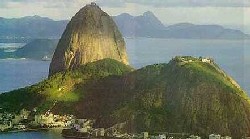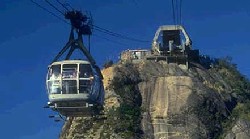Advertising by Google
Rio de Janeiro
Area: 1.261 km²
Population: 5.857.904 inhab. (est. 2000, including Metropolitan Area).
Visit map of State of Rio de Janeiro.
See also weather in Rio de Janeiro and Hotels in Rio de Janeiro.
Notice that people born in the city of Rio are called "cariocas", whereas people born in the State of Rio are called "fluminenses".
The first Portuguese explorers that arrived at Guabanara bay were amazed because of its extraordinary beauty. Rio de Janeiro grew up to the sides of the bay, to become what Brazilians call the Marvelous City (this song, called Cidade Maravilhosa, was recorded in 1935, and is played ever since in all Carnivals). Fantasy name to a perfect combination of sea, earth, climate and people. A nice mixture of the Indian, White and Black cultures, fermented in a magnificent natural scenery.
Tucked between the mountains and the sea, Rio de Janeiro is an unusual city on account of its geography and is certainly the part of Brazil that is best-known world-wide. At the very mention of the country even those with only the slightest knowledge of Brazil, automatically associate it with the "Marvelous City".
 The capital of Rio de Janeiro is endowed with a natural beauty that ranges from the beaches that indent the coastline, such as Arpoador, Ipanema and Copacabana, to the peaks that punctuate its landscape, such as the Corcovado and Sugarloaf Mountains. Rio contains the largest urban forest in the world, the Tijuca Forest, which was completely replanted during the second half of the nineteenth century.
The capital of Rio de Janeiro is endowed with a natural beauty that ranges from the beaches that indent the coastline, such as Arpoador, Ipanema and Copacabana, to the peaks that punctuate its landscape, such as the Corcovado and Sugarloaf Mountains. Rio contains the largest urban forest in the world, the Tijuca Forest, which was completely replanted during the second half of the nineteenth century.
The city is still one of the main sources of national culture and is the cradle of three types of Brazilian music - the choro, the samba and the bossa nova.
Cosmopolitan city, Brazil's capital for almost 200 years, Rio de Janeiro is one of the main culture centers on the country, with a lot of cinemas, theaters, museums, rooms of concert, show houses, art galleries and libraries. Big gastronomical zone, the restaurants on the city offer a lot of options, from international cookery to typical dishes from all Brazilian regions. Very few cities in the world are able to concentrate, in a very cool way, all the little icons that makes life a party: beach, sun, samba, frozen beer, tasteful food, football, beautiful people, streets with light curves that lead to little tropical forests.

Carnival in Rio
Many attribute the exuberant and infectious gaiety of Rio's citizens to the city's pulsating night-life, just as they attribute the poetry that springs from its corners and the flourishing of the arts to Rio de Janeiro's privileged geography. Side by side with this picture postcard city is another one set on the hillsides - the land of the overcrowded favelas and poverty but also the birthplace of Brazil's most popular festival, the annual carnival, known as Carnaval. Carnaval in Rio draws together rich and poor and all races to enjoy themselves in the clubs and on the streets with the added attraction of the world's largest samba parade that takes place in the Sambódromo, built in 1982 and designed by the Brazilian architect, Oscar Niemeyer.
Forty per cent of the state's population of 5.6 million inhabitants is concentrated in the capital and spread over more than one hundred and fifty districts. Some of these are of the traditional kind such as Santa Teresa which is reached by crossing an ancient aqueduct known as Arcos da Lapa. Other neighbourhoods are modern urban centres such as Barra da Tijuca on the waterfront. In addition, Rio de Janeiro has some of the most prestigious universities in Brazil with more than sixty post-graduate research centres covering different areas of learning.
 In the downtown area, the monuments and public buildings dating back to the time when Rio was the capital of the Colony, the Empire and the Republic of Brazil are amongst the country's finest cultural inheritances. The golden age of the city of Rio de Janeiro has left a legacy in the form of numerous major works of art and public buildings, such as the former headquarters of the Bank of Brazil, nowadays a dynamic cultural centre, the Municipal Theatre of Rio de Janeiro, the National Museum of Fine Art, the Itamaraty Palace, once seat of the republican government as well as the Foreign Office, the National Museum at Quinta da Boa Vista (former imperial residence), the National History Museum and the National Library, as well as monuments and beautiful examples of religious architecture, such as the Candelária and the São Bento Monastery.
In the downtown area, the monuments and public buildings dating back to the time when Rio was the capital of the Colony, the Empire and the Republic of Brazil are amongst the country's finest cultural inheritances. The golden age of the city of Rio de Janeiro has left a legacy in the form of numerous major works of art and public buildings, such as the former headquarters of the Bank of Brazil, nowadays a dynamic cultural centre, the Municipal Theatre of Rio de Janeiro, the National Museum of Fine Art, the Itamaraty Palace, once seat of the republican government as well as the Foreign Office, the National Museum at Quinta da Boa Vista (former imperial residence), the National History Museum and the National Library, as well as monuments and beautiful examples of religious architecture, such as the Candelária and the São Bento Monastery.
Photos: the Brazilian Travel Authority
Back to Top